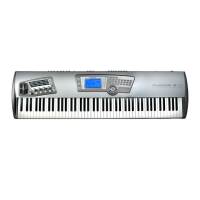ALESIS FUSION
ANALOG SYNTHESIS TUTORIAL
By tuning the oscillators apart in wide intervals with oscillator
sync on, many interesting new
waveshapes can be created that can
sound distinctly ‘un-analog’ and could almost have been
created on a digital synthesiser. There are no rules
for this - simply experiment using different
waveforms and interval tuning combinations.
However, a further side effect and benefit to this is that if
the frequency of the sync’d oscillator
is changed during the course
of a note, you get a distinctive ‘tearing’ sound not unlike a
very
strong flanger effect.
You can achieve this manually by controlling the pitch of the sync’d
oscillator using - say - the modwheel and using the effect as
a performance parameter (a
popular technique with
early synth players such as Jan Hammer or 80s synth pop-meister,
Howard Jones in ‘What Is Love?’)
or you can ‘automate’ it using LFOs and/or envelopes to
create many distinctive and classic ‘sync sweep’ sounds.
We will be looking at the use of controllers for this and the PWM sounds later in this tutorial.
Balancing / mixing the oscillators
You don’t always
want to have the oscillators at full level all the time - you will want to mix and
balance their relative
levels. For example, you might have a sound where one oscillator is an
octave or two up but you might only want a hint of that in the sound or you may want
to
emphasise a low
octave in a bass sound... or you may have tuned the oscillators a fifth apart
but don’t want the fifth element to
be too prominent. Or you may have mixed in a bit of white
noise that needs balancing against the pitched element of other oscillators... whatever.
All synths offer some way
of balancing the relative levels of the various oscillators. Some two
oscillator synths have a simple ‘balance’ control (which
can be inflexible) whilst other synths
have an oscillator mixer. Some, however, (like
Fusion) simply have an output level for each of
the oscillators.
As with most things about an analog synth, there are no rules - just adjust the
relative levels
according to taste and the requirements of the sound.
More modern VA synths such as Fusion also offer oscillator pan whereby the
oscillators can be
spread across the stereo image for a ‘wider’ sound. This can
be particularly useful when
creating
certain large, ensemble sounds such as strings and pads to create a wide stereo
sound (but can be a bit overpowering for
bass sounds which typically fare better placed mono
and central in the stereo image to create a solid foundation for the
track). Again, no rules - just
use your instinct... and experiment!
Sound generators - Conclusion
As you can see, the oscillators alone offer a
huge range of sounds to be created even before
we investigate the sound processors / modifiers and controllers. It’s worth getting to know
(and understand) the possibilities offered by the oscillators as they are the building blocks of
any sound... as mentioned, they can be compared to
the strings of an instrument and so play
an important part in any sound.
But don’t let this intimidate you - just experiment with different waveform, tuning and mixing
combinations until you arrive at something you like and progress from there.
Remember - it
doesn’t matter what you do, you can’t break anything by experimenting!
Sound generators
Page 9

